 |

The Best Source of Historical Research, Regardless of Topic
 |
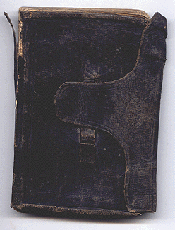
Most Civil War soldiers who kept diaries had a pocket diary similar to this one—leather outside with a tuck-in closure. These were small enough to fit easily in a pocket or a pack.
|
When it comes to historical research, few, if any, sources can compare to a personal diary in quality and bounty of information. Whether the reminiscences come from a notable statesman or a Southern belle, and whether the content is eloquent and meditative or perfunctory and journalistic, personal journals provide incredible historical perspective, insight, accuracy, detail and general information on periods of the past.
Research aside, of course diaries have become a very important category of collectible unto themselves. Many Civil War collectors, for instance, focus today on personal letters, official documents and personal journals. They enjoy the content as much as the insight in determining facts or value.
Although you won't find "Diaries" as a prices realized category on eBay or at auction houses, they are available from many other avenues. As many of our colleagues and customers know, the challenge is not necessarily in finding the diaries but in wading through the reams of pages, summaries or archives to determine if the piece holds the treasure of insight you need for your research or the content that rounds out your collection.
 |
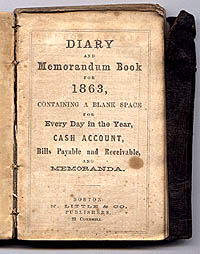
Many pocket diaries were like a Daytimer with space for daily entries, finances and other notations.
|
For this article we decided to use information from the largest seller of Americana ephemera, Heritage Auctions, to provide an interesting barometer of diaries for sale and their costs. We have used their auction catalog descriptions of diaries for sale to illustrate or summarize content. Naturally, if you are considering buying a diary or even using it for research you'll want to obtain the complete contents or at least detailed, accurate excerpts of most of it before deciding on its value to you.
Over the last decade, we have not seen a dramatic change in pricing, but we have seen more people collecting and thus more buyers at auction; that inevitably raises prices, even in a bad economy.
As with virtually all items discussed on these pages, prices fluctuate; in the case of diaries, the diarist can change the value tenfold. In the cases of the prices realized we have cited for diaries, there is NO APPARENT difference in the value based on either content or stature of the diarist. Again, we have cited auction catalog and promotional material descriptions for these lots, and we would have to say that all are "general . . . typical" diarist.
 |
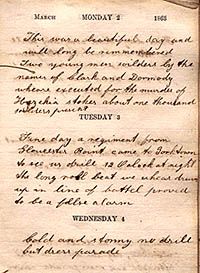
This is an actual group of entries for March 1863 in a soldier's diary.
|
One aside, when you're looking at Civil War letters, diaries or other personal correspondence (official documents as well), Confederate material is many times more scarce than Union material and consequently, many times more expensive. And, while virtually every diary contains something of value, it's not unusual to find those that are quite barren. For example, in our broad historic research that has encompassed topics from the Civil War to the World's Columbian Exposition to the Klondike Gold Rush, while just scanning everything on our radar over the years, we encountered three fairly innocuous sales offering "1893 diary for sale." One turned into a gem that was invaluable in book research on the WCE, the second was a quality WCE diary (but hardly the equal of the first) and the third was a salesman's notes and family musings that had no direct value on our projects or much value to anyone.
While we have not done an actual count or price versus origin survey, it seems fair to say that for every 100-plus letters on, say eBay, from Union soldiers, you may see one or two from the South; in the case of diaries, of 50–75 we've seen in the last couple of years, I don't recall one from the South, although there may have been one or two.
 |
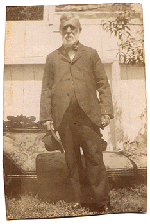
When the diary pictured above was found, this photo was tucked inside. Perhaps it was the diarist in later years or possibly the photo had been there in 1863, which would indicate it was the soldier's father or another relative whose picture he kept with him in the field in 1863.
|
We went to Heritage Auctions' archives to see what diaries they had sold in recent years. With minimal searching, we pulled the following sales directly from their database (another impressive resource available to you!). We have listed them simply as "DIARY" sales made at Heritage's auctions in 2007–2009. Naturally, we expected to find, and did find, the vast majority of diaries sold to be from the Civil War.
In the 2009 sales we located six diaries, all with simple descriptions. Three stand out by their topics as noteworthy: One belonged to a Union woman, two to Confederate soldiers. It was quite surprising to see two Confederate diaries. One might find more CW diaries by studying smaller, specialized auctions serving virtually only the CW market; but in surveying larger auction houses, we would expect the majority to be found right here in Heritage's files. Not surprisingly, the three most expensive Civil War diaries for '09 were these three. Women's diaries are not rare, but most collectors seek them for their unique perspective on life during the war; likewise, researchers are anxious to find the unusual stories as opposed to the common and/or repetitive battlefield diaries and the more prominent diaries of those soldiers recounting the mundane of military life for the family back home.
That Heritage sold two Confederate diaries last year is impressive and likewise, the prices of $2,988 and $3,884 were both strong, although we would not be surprised to see a Confederate diary with intriguing battle or other compelling content top $5,000.
In the Heritage '08 file, we know one item rather well, as it was ours, sold along with our collection of World's Columbian tickets: A young woman's diary chronicling more than 50 days at the fair, which brought $1,315. I would have valued the rare diary, rich with impressive content, at more than twice that hammer price. The collection of which it was a part, some 300 different tickets and passes to the WCE, including the diary, brought nearly $40,000. Overall, stepping back from it, it was a decent price and certainly the largest WCE ticket collection sold since Tom Diddle's landmark collection was offered some twenty years earlier.
 |
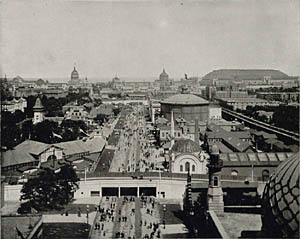
The World's Columbian Expo diary we sold as part of our WCE ticket collection was about the same size as the Civil War pocket diary but was a leather memo book of blank pages, bound on the narrow side. Our young Columbian diarist wrote about the 50 visits she made to the fair in 1893. This is one of fairgoers' favorite views—looking east toward Lake Michigan and much of the fairgrounds from the top of the world's first Ferris wheel.
|
Since we do not have details here of the content of the diaries, we can only assume that the poster boy of Heritage's '08 sales—a diary bringing $11,353—had terrific content.
Also on the '08 list was a diary described as written by an Andersonville prisoner, which brought $4,780. It's impossible to determine the content, but any Civil War historian or collector would have heart palpitations over gaining access to a lengthy diary of life within the vile and deadly confines of Andersonville. It would be difficult to imagine the diary being anything short of heart-stopping.
Another 2008 diary in the Heritage archives brought a paltry $191, but while it was called a diary by Heritage, it was listed as a "Daytimer"—belonging to Buzz Aldrin. Suffice it to say, if it included ANY of his notes while aboard a U.S. spacecraft, let alone on his journey to the moon, one would assume it would bring $10,000-plus. Our guess is that in one of Heritage's many "Space Exploration" auctions, several pieces belonging to Aldrin were sold, among them this Daytimer, for which year we haven't a clue. Still, if it noted anything more than "bring home milk and bread," that $191 price tag seems ridiculously low.
In 2007, Heritage sold another Andersonville diary; this piece brought $8,365 versus the $4,780 in 2008. Although it's only speculation in this case, we know for a fact that a great many Heritage lots are won at a Heritage sale—and are consigned shortly thereafter by the winning bidder, anxious to grab a short-term profit. We don't know for certain in this sale, but we would guess that it was far more likely that the same diary passed the block at Heritage twice (in '07 and then '08) than that Heritage had the opportunity to sell a completely different Andersonville diary the following year.
Finally, in reviewing this very interesting file of sales from Heritage, the eyebrow raiser wasn't from the Civil War, or from an astronaut, or the couple of outstanding sales of pre-CW diaries. Of Heritage's 23 diary sales in 2007–2009, two belonged to recently deceased actress Anna Nicole Smith. Heritage sold, for the heirs, Smith's 1994 and 1992 personal diaries. Each brought $29,875. Sad but true, the sensationalism and 'gotta know' mentality always boosts contemporary entertainment diaries into a realm miles above the historically significant, but the value is shorter lived. No offense to Ms. Smith, but her personal musings, while interesting to the masses, probably will have very little significance and far less interest than a CW battlefield or prisoner of war diary a few decades down the road.
While the value may have little pertinence here, we did note a diary in 2006 sold by Heritage that we'd rate as an incredible steal. For only $6,573, someone purchased a diary kept by James Naismith at the 1936 Berlin Olympics. It's difficult to imagine that "only" 74 years ago the man who invented the game of basketball was in Berlin watching it played as a gold medal sport. His diary no doubt included unbelievably insightful and rare comments on the changing face of HIS game. Imagine if he had lived to see today's super athletes by comparison seemingly flying up and down the court and soaring to the boards in the same game in which Naismith's students methodically endeavored to heave a ball into a peach basket nailed to the wall.
As an aside, Naismith was born as the Civil War dawned in 1861. He invented his game in 1891, and founded the University of Kansas' basketball program. When he attended the Berlin Olympics in 1936, his sport was only 45 years old, but while it was introduced as an Olympics demonstration sport as early as 1904, in Berlin it was accepted and played as a medal sport for the first time—and the 75-year-old inventor was there to witness it. He died just a few years later.
Following are examples of prices for diaries—usually sight unseen—from Heritage auctions, certainly the dominant auction house for all types of collectibles, with $600 million in annual sales. If you're not familiar with Heritage, you should get familiar if you're in the market for any of the types of collectibles sold by the mammoth auction house, designated as follows:
| |
• |
Coins/Numismatics |
| |
• |
Stamps |
| |
• |
Rare Books and Manuscripts |
| |
• |
Civil War, Military/Weapons |
| |
• |
Tokens and Medals |
| |
• |
Texania, Western Americana |
| |
• |
Photography |
| |
• |
Space and Aviation |
| |
• |
Fossils and Minerals |
DIARY PRICES REALIZED, 2007–09
| Year |
Description |
Price |
| 2009 |
CW Union Soldier's Diary |
$1,076 |
| 2009 |
CW Union Soldier's Diary |
$657 |
| 2009 |
CW Confederate Soldier's Diary |
$2,988 |
| 2009 |
CW Confederate Soldier's Diary |
$3,884 |
| 2009 |
CW Union Soldier's Diary |
$1,554 |
| 2009 |
CW Union Woman's Diary (We doubt this a diary of a Union woman soldier, as only a handful of women served in combat roles in the Army—those disguised as men; such a diary would bring tens of thousands of dollars even in today's struggling economy! This is probably a nurse or woman writing about military topics, or a wife's musings about her soldier husband) |
$2,629 |
| 2008 |
Young Woman's 50-plus Days at the World's Columbian Exposition. (This was sold as part of our collection of WCE tickets, and while a 'strong' price from Heritage's standpoint, we felt it was underpriced.) |
$1,315 |
| 2008 |
CW Soldier's Diary that did NOT sell at auction; sold for the reserve after the auction |
$11,353 |
| 2008 |
CW Union Soldier's Diary sold as part of a lot including various other items belonging to the same soldier |
$5,378 |
| 2008 |
CW Union Soldier's Diary |
$2,151 |
| 2008 |
CW Union Soldier's Diary of his stay at the horrific Confederate Andersonville Prison. Any such diary should be considered exceedingly rare and as such, we would view this price in the "bargain" category, of course dependent on length and content. |
$4,780 |
| 2008 |
CW Confederate Soldier's Diary |
$3,107 |
| 2008 |
Diary of 1870s exploration of Yellowstone and other Western areas |
$1,673 |
| 2008 |
Buzz Aldrin, astronaut/moon exploration astronaut, his personal Daytimer/notes that were assumed to have some references to training, meetings and NASA related subjects. Based on the price, it was clearly of minimal interest; still, any aviation collector or astronaut researcher would have to consider $191 a bargain without knowing anything about the content in advance. |
$191 |
| 2007 |
Life in 1858. Although pre-Civil War, the description suggested interesting content regarding politics and slavery. |
$956 |
| 2007 |
CW Union Soldier's Diary |
$5,676 |
| 2007 |
Diary of a US Navy Seaman with discussions of an 1810 rescue at sea |
$1,912 |
| 2007 |
CW Union Soldier's Diary |
$1,436 |
| 2007 |
CW Union Soldier's Diary of his stay at Andersonville (We suspect that this may be the same diary resold in 2008; the difference in this price of $8,365 vs. a similarly described diary a year later at $4,780 had LITTLE or nothing to do with content, but reflects the drop in prices due to the economy, which has played havoc with some, but not other collectibles. |
$8,365 |
| 2007 |
CW Confederate Soldier's Diary, which can be compared to $3,107 the next year and two Confederate Soldier Diaries averaging $3,446 in 2009—again, likely due to the foundering economy. |
$5,079 |
| 2007 |
Anna Nicole Smith 1992, Part I. We include this auction because Heritage included it in its typical run of auctions and promoted the content as a glimpse into the movie star's life prior to her tragic death. No claims were made that the content included anything linked to her death, but clearly the timing was impeccable for the seller, capitalizing on publicity around the star. Unless there is/was amazing content, one could expect these diaries to fetch perhaps 10% of this amount 5–10 years down the road. |
$29,875 |
| 2007 |
Anna Nicole Smith 1994, Part II |
$29,875 |
|
|
 |
|
 |
2010 #2, May–June
The History Bank Announces Auction Dates
What's It Worth?
Spectacular World's Columbian Medal Discovered in Estate
Personal Diaries: The Best Source of Historical Research, Regardless of Topic
An In-depth Look at R-1 to R-9 Rarity Scales
Past issues:
2010 #1, January–February
View issue contents
|
A PRIMER ON HERITAGE AUCTION GALLERIES
We have dealt personally with Heritage since the 1990s. The chairman of the company, Greg Rohan, was a young numismatist in Seattle when we first started our business. In the exciting days of coin buying and selling, accelerated by the boom in bullion (which of course we later discovered was market manipulation by the Hunt Brothers of Texas, doing what no one ever would have felt possible by a single individual!), in 1979–1980 there was a monthly coin show in downtown Seattle, on the grounds of the 1962 Seattle World's Fair. We set up in our same location at the back of the room every month on a Saturday morning, and went home dinnertime on Sunday.
We already specialized in world's fair ephemera, historical paper, tokens and medals. Rohan had a reputation for a keen eye for quality and price in U.S. coins; he didn't set up a table space, but did his business from dealer to dealer. He was still in his teens!
Rohan joined Heritage and today, of course, is the president of the company. One small item that may go unnoticed in Heritage's beautiful and professional literature is the line that refers to the company as the world's largest collectibles auction house. In 2008 and 2009 accompanying that reference was a statement that Heritage sold $700 million at auction annually. That is an astounding number, and when one thinks that the company's average sales commission is 10–15 percent, and its average buyers' commission has risen to 19.5 percent, it doesn't take a math honor student to see that the company's gross revenue for its auctions at 29.5–34.5 percent of $700 million is more than $200 million. But recently, despite the company's growth with equally impressive quality items in new areas (such as art, minerals, jewelry, etc.) Heritage's most recent literature rather nonchalantly changed its annual collectibles sales volume to "only" $600 million, a quiet but massive $100 million decline in gross business.
Despite continued dominance and very impressive new growth areas, Heritage apparently has felt the bite of the down economy along with the rest of us, seeing total sales dropping 15 percent this year versus last!
|
|
|
 |